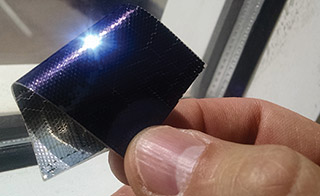The turning wheel of fortune lifts the avatar of solar
Entrepreneurial life holds both attractions and unknowns for Sandians considering that path. In an effort to shed more light on the realities of starting a high-tech business, the Lab News is following the efforts of the fledgling company mPower to grow its own wings. On Oct. 2, our first installment was titled “Why attempt the entrepreneurial life?” Following is the second installment on the mPower effort, from a perspective of two months later. You can also read the previous chapter in this saga here.
Chapter 4: Staying cool as stress deepens

In a cheerful red-plaid sweater and looking relaxed, Murat Okandan, CEO of mPower (empower), the solar start-up of which he is chief executive and sole employee, waved me over to his table at Flying Star, where he was enjoying tea and cookies.
I expected some sign of stress. When he took entrepreneurial leave from Sandia nine months earlier, the company with its initial group of entrepreneurial Sandians was flush with talent. Now, after some differences of opinion and tightening of belts, only Murat was left to tell the story. I also knew some important funding had ceased from an international energy company formerly helping to float the organization.
“Why aren’t you looking more haggard?” I said. “Tearing your hair?”
“Would it help?” he said, smiling.
“Are you living more frugally?”
“Not unreasonably frugally, but more frugally.”
“Are you so calm because you’re not all in? Because you can always pull the ripcord and float back to your job at Sandia?”
“It’s not like I’m out of a job and don’t know where to go,” he conceded. “But the bigger risk is that we have something valuable and can’t deliver it.”
His wife is supportive, he said.
“But money is not the key factor,” he said. “My target date depends on whether certain things that need to be accomplished by a certain period are done. There are things this solar technology can do, and there’s only a limited time to bring it to a certain level of maturity. Either it’ll be dropped or someone else will take it. Then it’s time to make other decisions.”
Would that be returning to Sandia?
“There might be other opportunities as a result of the business and scientific interactions I’ve had through mPower.” He took a sip of tea. “But I’m still here.”
The company’s immediate goal is to commercialize very small, very thin photovoltaic particles, previously described as solar glitter – now Dragon SCALEsTM, created in wafers, and interconnected into a hyper-dense network. The particles are so thin, light, and strong that Murat believes they are a natural for space flight, stored at take-off as a tiny, robust, ultralight package that can be opened in space to create an ultralarge solar array. The array would provide the right kind of power to enable electric propulsion and ion drives that allow satellites to change and maintain orbits. They would also be inexpensive and efficient to install on rooftops and in large solar-power farms when configured for terrestrial solar power, at a cost level below what current technology can offer, Murat says.
Potential customers have told him “they want this product variant or that,” he said. “It could happen faster if projects were more lined up with customers and the business side of things more mature, but everything takes longer than you expect.” A 300-kilowatt solar array for space applications is an attractive target, he says, and his technology could bump up to one megawatt or more per payload, with the right projects, partnerships, and resources in place.
Then he looks at me with a certain intensity. “There’s going to be a very rapid transition, from electricity distributed by large power plants to electricity individually produced, stored, and traded,” he said. “Individual production will be more efficient, with lower cost, higher reliability, and better able to predict how much is being produced. I want to help make that happen.”
He had told me that months ago, but his desire to advance humanity got buried in my mind under more mundane items: the nuts and bolts of financing, product, customers. But now, seeing the idea sally forth again from Murat, it’s clear that entrepreneurs need belief to hurdle any broken bridges in the so-called valley of death, which slays most new ideas coming to market when the oxygen of money gets too thin for the entrepreneurial swimmer to reach the far shore of production. An entrepreneur may need belief that overrides the hesitations of “realists.”
At the bottom of his calm, the fire that drives Murat is a deep-felt passion that solar power represents humanity’s best future, and he intends to be one of the leaders of that effort.
Chapter 5: But wait — the wheel turns!

PHOTOVOLTAICS: THE NEXT GENERATION? — The “dragon scales” of mPower require far less silicon than conventional photovoltaics, and rest on a bendable substrate. Their lightness and flexibility could make them the industrial choice to provide power to satellites in space.
One week later, Murat has gotten some very good news, showing that fortune favors the stubborn:
First, he’s engaged two backers whose financial support will enable him to proceed with fabrication efforts “to deliver prototypes to our first customers, and to continue conversations with other potential investors.” His now-doable game plan is, in six months, to have commercially relevant prototypes to present that are ½ x 1 meter instead of early prototypes of ½ inch x 1 inch. The prototypes will be lightweight, very powerful in a small area, demonstrate less degradation, a low failure rate, and enable real-time state-of-health monitoring.
“We’re going to change the way photovoltaics are put together and operated, which are key issues for industrial customers,” he says. “This is an initial portion to get things rolling.” He has proposals out to DOE, NASA, and ARPA-E for projects that will support development of products and commercialization of the technology.
Second, former Sandia executive Pete Atherton, who just retired from Sandia, has come on board at mPower as chief operating officer. Pete’s experience in building new businesses include two successful tech startups, he says.
“It will be challenging to build a business around an early-stage technology, but that is the life of a tech startup,” Pete says. “The last venture-backed startup I was with as COO was a renewable tech company that successfully sold to a utility and gave nice returns to the investors. I hope to bring that experience to mPower to help Murat utilize the Sandia breakthrough technology to grow a very successful business.”
So, it’s on. We’ll be back to report on future bumps and elevations in the mPower road. Godspeed, Murat, Pete, and their unnamed investors: Travel at solar warp speed.